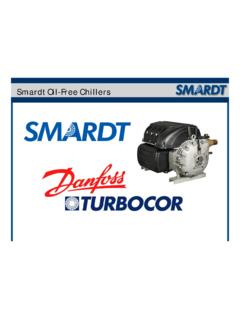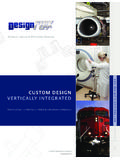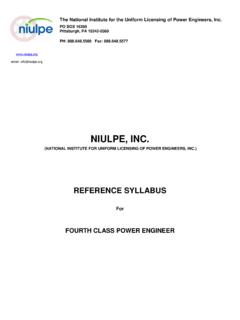Transcription of NY AEE - BOILERS 101 (SEPT 2014) Website
1 1 BOILERS 101 Asit PatelANP Energy Consulting Services1 Learning objectives Define what is a boiler ? What are different classification of BOILERS ? Define combustion efficiency, thermal efficiency, and fuel to fluid efficiency. Identify different type of BOILERS Criteria for boiler selection22 Lets look at what the Merriam-Webster dictionary says the boiler is a boiler ? A boiler is a closed metal container (pressure vessel) in which water is heated to produce steam and heated water3 boiler Classifications Low Pressure: Section IV of ASME Code (Heating boiler ) Steam: Up to 15 PSIG Water:Up to 160 PSIG and or 250 F High Pressure: Section I (Power boiler ) of ASME Code Steam: Above 15 PSIG Water: Above 160 PSIG and or 250 F5 boiler Efficiency Classification Standard Efficiency (80-84%) Most Steel and Cast Iron BOILERS Mid Efficiency (85-90%) Copper Fintube BOILERS High Efficiency (90%+) Condensing Boilers6 Non-Condensing4 Defining boiler Efficiency Combustion Efficiency- indicates a burners ability to burn fuel measured by unburned fuel and excess air in the exhaust.
2 Thermal Efficiency- indicates the heat exchangers effectiveness to transfer heat from the combustion process to the water or steam in the boiler , exclusive radiation and convection losses . Fuel to Fluid Efficiency- indicates the overall efficiency of the boiler inclusive thermal efficiency of the heat exchanger, radiation and convection losses -output divided by input. 7 Where do we get input and output information for a boiler ?8 boiler Brochure5 boiler CapacityUnits of Measurement Input (Firing rate) GPH Gallons per hour MBH (M = 1,000 btu) Output BHP = boiler Horse Power = 33,475 btu Sqft of steam = 240 btu lbs/hr ( lbs of steam = 1 BHP)9 What is a BTU? British Thermal Unit (btu) = Unit of measurement of heat energy. Amount of heat energy required to raise one pound of water by one degree Fahrenheit.
3 One gallon of water = lbs Approximate amount of heat released by one kitchen of BOILERS Cast Iron Sectional Scotch Marine Steel Firetube Firebox Watertube Low water content copper fin tube type Condensing boilers11 Types of Boilers127 Types of BOILERS Cast Iron Sectional Scotch Marine Steel Firetube Firebox Watertube Low water content copper fin Condensing boilers13 boiler TypesCast Iron Sectional148 boiler TypesCast Iron BOILERS Advantages modular Design High Number of Options Low Initial Cost Durable Construction Disadvantages Low Pressure Only Limited to 200 horsepower Not Recommended For Process Applications Medium to High Level of Maintenance Low Efficiency in Field15 Types of BOILERS Cast Iron Sectional Scotch Marine Steel Firetube Firebox Watertube Low water content copper fin Condensing boilers169 boiler TypeSteel Firetube Scotch17 Two Pass DrybackThree Pass WetbackBoiler TypeSteel Firetube Scotch - Four Pass - Wetback1810 boiler TypeSteel Firetube Scotch - Wetback Design Principles Rear turnaround is totally surrounded by water No expensive refractory to maintain Rear doors are either lightweight lift off type or split-hinged 19 boiler TypeSteel Firetube Scotch - Dryback Design Principles Rear turnaround is a refractory wall Door refractory is a maintenance item Rear door is vessel-sized in diameter, extremely heavy.
4 And hinged or davited2011 boiler Type Steel Firetube Scotch - Dryback21 boiler TypeSteel Firetube Scotch Advantages Wide range of sizes Both high and low pressure Higher Efficiency Easy to clean No mud legs Longevity No refractory floor No rear door refractory (3-Pass & 4-Pass Wetback Only) Disadvantages Operating weight Requires more floor space Space required for tube removal & cleaning Refractory Maintenance (dryback design only)2212 Types of BOILERS Cast Iron Sectional Scotch Marine Steel Firetube Firebox Watertube Low water content copper fin Condensing boilers23 boiler TypeSteel - Firebox2413 boiler TypeSteel - Firebox Advantages Wide range of sizes Compact (for places where Scotch will not fit) Easy to clean Longevity Disadvantages Low Pressure ONLY Operating weight Refractory maintenance costs Space required for tube removal & cleaning (but not as much as Scotch)25 boiler TypeModified Firebox (fits through 36 door)2614 Types of BOILERS Cast Iron Sectional Scotch Marine Steel Firetube Firebox Watertube Low water content copper fin Condensing boilers27 boiler TypeFlexible Watertube2815 boiler TypeFlexible Watertube Advantages Lower Cost Lower operating weight Long life expectancy (40 Years) Wide range of sizes Knockdown capability Minimum space required for tube removal & cleaning Tubes easily replaced Disadvantages Low Pressure Application ONLY Water treatment more critical (difficult to clean)
5 29 boiler TypeSteel - Watertube D Type S Type A Type O Type3016 boiler TypeSteel Watertube31 boiler TypeSteel - Watertube Advantages High Pressure up to 900 psig Fast Steaming Low Water Content Quick Response to Load Demands Disadvantages Steam Only Process Only3217 Types of BOILERS Cast Iron Sectional Scotch Marine Steel Firetube Firebox Watertube Low water content copper fin Condensing boilers33 boiler TypeCopper Fin Tube Horizontal Lay-out34 Source: Hydronic InstituteInstallation Guide: Residential hydronic heating Guide 200018 boiler TypeCopper Fin Tube Vertical Lay-out35 boiler TypeCopper Fin Tube Advantages Medium efficiency Low initial cost Low Mass Low operating weight Small footprint Lower stand-by losses Disadvantages Gas only Water only Special vent requirements3619 Types of BOILERS Cast Iron Sectional Scotch Marine Steel Firetube Firebox Watertube Low water content copper fin Condensing boilers37 boiler TypeHigh Efficiency Condensing Boilers3820 True Operating Efficiency of Condensing Boiler39 Condensing BOILERS actually operate at higher part-load efficiency while in condensing TypeHigh Efficiency Condensing BOILERS Advantages Highest Efficiency Can be used in low RWT systems Various types Condensate will not harm properly designed
6 boiler Standard features & Controls Smaller Venting Disadvantages Water only Gas only Special venting Costly???402141 TYPES OF BOILERSA tmospheric - Gas Increased standby losses Air from building free to move through units and up through stack at all timesTypes of BOILERS Knockdown boiler (vessel) only Packaged boiler and burner May be the same manufacturer or may be two different manufacturers Mostly two different manufacturers Integral unit boiler and burner is one unit Most condensing boilers4222 Criteria for boiler selection Application Heating/Process Steam/Hot Water High Pressure/Low Pressure Fuel availability and venting options Space availability Budget Efficiency43 What makes one boiler more efficient than other? Capability to transfer more BTU s from combustion process to make hot water or steam.
7 Heat exchanger design and construction Lower jacket and stand-by losses Better insulation and heat exchanger isolation during off cycles. Capability to match the boiler s output to actual load Better modulation capability (higher turn-down ratio)4423 From operating The best boiler for your application is the one that is properly sized to match your load. A boiler that runs do we achieve Multiple smaller capacity Larger boiler (s) with modulation burner Turn down ratio Typical 4:1 (100% 25%) 5:1 (100% - 20%) Highest - 20:1 (100% - 5%) But then, what about part load efficiency?4624 Part-Load Efficiency Curves of Non-condensing High Mass boiler47 Typical high mass BOILERS have low part-load concern is flue gas Load Efficiency of Condensing Boiler48 Condensing BOILERS actually operate at higher part-load efficiency while in condensing What Makes Condensing boiler Efficient?
8 Condensation of water vapor. Extraction of latent heat that is otherwise going up the chimney in form of water and Combustion Fuels are Hydro-Carbons Oxygen is 21% of air (78% is Nitrogen) HC + O2 Good, complete combustion CO2 + H20(vapor)+ heat Incomplete combustion of gas CO2 + CO+ H2O + heat Incomplete combustion of oil CO2 + CO + C+ H2O + heatFlame QualityCarbon Monoxide hazardSoot = $ lost 26 Energy Improvement Opportunities Associated with BOILERS /burners Maximize combustion efficiency Minimize excess air Maximize heat exchange Clean up fireside and waterside fouling Minimize stand-by losses Jacket losses and cyclical losses51 How much excess air should we strive for?52 FEMP O&M Manual Ve r. 3P. in field53 Lowering of excess air results in lower exhaust gas temperature and higher efficiencySoot on Heat Exchanger Acts as an insulator Increases amount of heat lost through chimney54 Heating System Efficiency28 Scale on Water Side of Heat Exchanger Acts as an insulator More heat lost through chimney55 Heating SystemEfficiencyJust so that you know that I am not making these things Opportunity (Minimize stand-by losses)If this damper is left in open position, it can significantly impact the stand-by losses and if not adjusted properly can have significant impact on combustion You5830Q & A59


